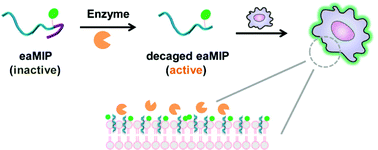Enzyme-activated anchoring of peptide probes onto plasma membranes for selectively lighting up target cells†
Abstract
In a cellular microenvironment, numerous biomolecules are involved in various physiological and pathological processes. However, for the in-depth and comprehensive understanding of their roles at the molecular level, there is still a lack of detection techniques for the in situ tracking of these biomolecules in a local environment. Herein, we engineered a membrane insertion peptide (MIP) as an enzyme-activated membrane insertion peptide probe (eaMIP) that allowed the in situ tracking of the activity of target enzymes in living cells. In this strategy, the membrane insertion capacity of the MIP motif in each eaMIP was caged by appending a chemical moiety. In the presence of target enzymes, the caging moiety in each eaMIP was removed by enzymatic decaging, leading to the generation of active MIPs. The versatility of this design was demonstrated by lighting up different tumor cells with distinct fluorescence signal patterns, affording an alternative tool for clinical diagnostics, biochemical research and membrane engineering.



 Please wait while we load your content...
Please wait while we load your content...